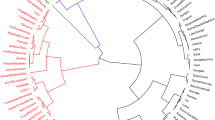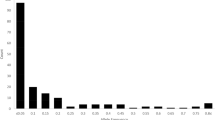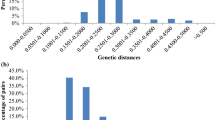Abstract
This study applied two methods to assess intra-collection duplication within 339 Nordic oat (Avena sativa L.) accessions preserved by Plant Gene Resources of Canada (PGRC). Putative duplicates, that is accessions carrying a similar accession name, were grouped into 52 duplication groups and included 230 of the 339 Nordic oat accessions. A field assessment based on visual inspection of field plots was conducted during two growing seasons to detect distinct phenotypes within each duplication group. Simultaneously, a descriptor assessment using seven characters with altogether sixteen character states was used in both years for the same purpose. The combined results of both assessments and both years indicated that among the 230 accessions in duplication groups only 118 could be identified as distinct. This would allow for a reduction of 33% of the Nordic oat accessions at PGRC. The field assessment method detected fewer (75%) distinct accessions than the descriptor assessment (84%), when considering all accessions identified as distinct as 100%. Repeatability between years was higher in the field assessment (70%) than in the descriptor assessment (64%). The field assessment requires an experienced germplasm evaluator, but allows for handling large numbers of germplasm accessions and for detecting functional, fitness related, and user-relevant diversity. Combining field assessment with descriptor assessment and more sophisticated methods on selected subgroups may be the most efficient method for determination of internal duplication in genebank collections. Bulking phenotypically similar accessions within duplication groups is preferable to eliminating duplicate accessions when collection rationalization is required, as it reduces the risk of loosing diversity.



Similar content being viewed by others
References
De Haan H (1954) Oat breeding in the Netherlands. Euphytica 3:81–180. doi:10.1007/BF00029954
Diederichsen A (2008) Assessments of genetic diversity within a world collection of cultivated hexaploid oat (Avena sativa L.) based on qualitative morphological characters. Genet Resour Crop Evol 55:419–440. doi:10.1007/s10722-007-9249-y
Diederichsen A, Timmermans E, Williams DJ, Richards KW (2001) Holdings of Avena germplasm at Plant Gene Resources of Canada and status of the collection. Oat Newsl 47:35–42.
Fowler C (2007) Global dimensions of conserving crop diversity. Seed Savers 2006 Harvest Edition. Seed Savers Exchange Inc, Decorah, pp 33–42
Fu YB (2006) Redundancy and distinctness in flax germplasm as revealed by RAPD dissimilarity. Plant Genet Resour 4:117–124. doi:10.1079/PGR2005106
Grau Nersting L, Andersen SB, von Bothmer R, Gullord M, Bagger Jørgensen R (2006) Morphological and molecular diversity of Nordic oat through one hundred years of breeding. Euphytica 150:327–337. doi:10.1007/s10681-006-9116-5
Hammer K (1993) The 50th anniversary of the Gatersleben genebank. Plant Genet Resour Newsl 91/92:1–8
Hammer K (2003) A paradigm shift in the discipline of plant genetic resources. Genet Resour Crop Evol 50:3–10. doi:10.1023/A:1022944910256
Horneburg B, Becker HC (2008) Crop adaptation in on-farm management by natural and conscious selection: a case study with lentil. Crop Sci 48:203–212. doi:10.2135/cropsci2007.03.0170
Lehmann CO, Mansfeld R (1957) Zur Technik der Sortimentserhaltung. Kulturpflanze 5:108–138. (On the technique for collection-maintenance.) doi:10.1007/BF02095492
Love B, Spaner D (2007) Agrobiodiversity: its value, measurement, and conservation in the context of sustainable agriculture. J Sustain Agric 31:53–82. doi:10.1300/J064v31n02_05
Lund B, Ortiz R, Skovgaard IM, Waugh R, Andersen SB (2003) Analysis of potential duplicates in barley gene bank collections using re-sampling of microsatellite data. Theor Appl Genet 106:1129–1138
McKenzie RIH, Harder DE (1995) Oat. In: Slinkard AE, Knott DR (eds) Harvest of gold: the history of field crop breeding in Canada. University Extension Press, Saskatoon, pp 98–112
Nordic Genebank (2008) SESTO Gene bank documentation system. http://tor.ngb.se/sesto/index.php?scp=ngb&thm=sesto&r=437596376. Accessed 18 September 2008
Phippen WB, Kresovich S, Candelas FG, McFerson JR (1997) Molecular characterization can quantify partition variation among genebank holdings: a case study with phenotypically similar accessions of Brassica oleracea var. capitata (cabbage) ‘Golden Acre’. Theor Appl Genet 94:227–234. doi:10.1007/s001220050404
Rodionova NA (1974) Opredelenie podlinnosti vidov i sortov ovsa po morfoligičskim priznakam zerna. [Determination of authenticity of oat species and cultivars by morphological characters of the grain]. Trudy po prikladnoj botanike, genetike i selekcii 51(2):54–61
Sackville Hamilton R, Engels JMM, van Hintum ThJL (2003) Rationalization of genebank management. In: Engels JMM, Visser L (eds) A guide to effective management of germplasm collections. IPGRI, Rome, pp 80–92
Stanton TR (1955) Oat identification and classification. Technical Bulletin No. 1100. United States Department of Agriculture, Washington DC
Timmermann M (2006) The breeder’s eye – theoretical aspects about the breeder’s decision-making. In: Øestergård H, Fontaine L (eds) Proceedings of the COST SUSVAR workshop on cereal crop diversity: implications for production and products, 13–14 June 2006, La Besse, France. ITAB, France, pp 118–123
Timmermann M (2007) Phänomenologie der Natur: eine methodologische Erweiterung der quantifizierenden Naturwissenschaften [Phenomenology of nature: methodological amplification of the quantifying natural sciences]. In: Zikeli S, Claupein W, Dabbert S, Kaufmann B, Müller T, Valle Zárate A (eds) Proceedings of Zwischen Tradition und Globalisierung—9. Wissenschaftstagung Ökologischer Landbau, Universität Hohenheim, Stuttgart, Deutschland, 20–23 March 2007, vol 2, pp 787–790. Köster, Hohenheim (Also available at: http://orgprints.org/9453/. Accessed 18 September 2008)
Van Hintum ThJL (2000) Duplication within and between germplasm collections III. A quantitative model. Genet Resour Crop Evol 47:507–513. doi:10.1023/A:1008703031415
Van Hintum ThJL, Knüpffer H (1995) Duplication within and between germplasm collections I. Identifying duplication on the basis of passport data. Genet Resour Crop Evol 42:127–133. doi:10.1007/BF02539516
Van Hintum ThJL, Visser DL (1995) Duplication within and between germplasm collections II. Duplication in four European barley collections. Genet Resour Crop Evol 42:135–145. doi:10.1007/BF02539517
Van Hintum ThJL, Sackville Hamilton NR, Engels JMM, van Treuren R (2002) Accession management strategies: splitting and lumping. In: Engels JMM, Ramanatha Rao V, Brown AHD, Jackson MT (eds) Managing plant genetic diversity. International Plant Genetic Resources Institute, Rome
Van Treuren R, van Hintum ThJL, van de Wiel CCM (2008) Marker-assisted optimization of an expert-based strategy for the acquisition of modern lettuce varieties to improve a genebank collection. Genet Resour Crop Evol 55:319–330. doi:10.1007/s10722-007-9237-2
Van Treuren R, van Soest LJM, van Hintum ThJL (2001) Marker-assisted rationalization of genetic resources collections: a case study in flax using AFLPs. Theor Appl Genet 103:144–152. doi:10.1007/s001220100537
Virk PS, Newbury HJ, Jackson MT, Ford-Lloyd BV (1995) The identification of duplicate accessions within a rice germplasm collection using RAPD analysis. Theor Appl Genet 90:1049–1055. doi:10.1007/BF00222920
Yang RC, Jana S, Clarke JM (1991) Phenotypic diversity and association of some potentially drought-responsive characters in durum wheat. Crop Sci 31:1484–1491
Zade A (1918) Der Hafer – eine Monographie auf wissenschaftlicher und praktischer Grundlage [Oats – a monograph on scientific and practical grounds]. Gustav Fischer, Jena
Zeven AC, Dehmer KJ, Gladis T, Hammer K, Lux H (1998) Are the duplicates of perennial kale (Brassica oleracea L. var. ramosa DC.) true duplicates as determined by RAPD analysis? Genet Resour Crop Evol 45:105–111
Acknowledgement
The technical assistance of Mr. D.J. Williams for setting up the field plots and careful descriptor evaluation of the germplasm is greatly appreciated.
Author information
Authors and Affiliations
Corresponding author
Rights and permissions
About this article
Cite this article
Diederichsen, A. Duplication assessments in Nordic Avena sativa accessions at the Canadian national genebank. Genet Resour Crop Evol 56, 587–597 (2009). https://doi.org/10.1007/s10722-008-9388-9
Received:
Accepted:
Published:
Issue Date:
DOI: https://doi.org/10.1007/s10722-008-9388-9




